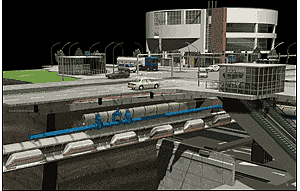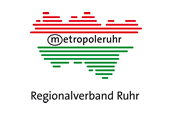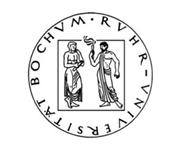Main topic: Renewing the infrastructure
Subtopic: Traffic, universities, open space

Infrastrukturelle Innovation - Cargo Cap
Quelle: Institut Prof. Dr. Stein, Ruhr-Universität Bochum
Quelle: Institut Prof. Dr. Stein, Ruhr-Universität Bochum
The infrastructure of the old industrial region had completely been orientated to the needs of the industries. The various networks (works railways and streets, canals) intensively intersected both the built-up areas and the open spaces. Quite often the tracks run on dams or are flanked by dykes thus increasing the impenetrability. In addition there are the tube and high power line networks. The extended works areas were surrounded by high fences and walls and thus became ?forbidden cities?. As it was not intended to keep the workers mobil, but to bind them locally and regionally, the costs to transfer the traffic systems into the mobility orientated post-industrial times were as increased as they were for the improvement of the housing and leisure sites.
Inland navigation and harbour areas saw a radical devaluation and then a re-evaluation. Housing, leisure and office sites on the waterside happen to see boom (e.g. Inner harbour Duisburg) and are even newly developd (Emscher Lake Phoenix in Dortmund).
Already in 1920, the just founded ?Siedlungsverband Ruhrkohlenbezirk (SVR)? safeguarded the open, green and recreation spaces as a matter of priority. These intentions have been continued by a regional open space system (Regionales Freiraumsystem) and by the IBA-induced Emscher landscape park (Emscher Landschaftspark) (see below). The spatial retreat of the coal and steel industry left behind large amounts of brown fields that are praised as the centennial chance of urban development (see below) and may give new impulses to the open space system (e.g. landscape park Duisburg, industrial woodlands on waste tips, water areas as the Lake Phoenix).
?Post-industrial urban nature? areas could be of importance for the climatic change and could help to define the new guidelines of ?the city of tomorrow?. But the potentials are not properly recognized yet.
Subtopic: Structural policy for the Ruhr
Phase 1 (1966 ? 1974): Integrated structural policy
As the end of the coal and steel era became obvious in the 1960s plans to launch a comprehensive re-industrialisation of the Ruhr were thwarted by the opposition of the regional coalition of interests and by the ?mental burdens?. Nevertheless, some core issues of the integrated, economic, social and infrastructural renewal could be accomplished. The region was opened up as intraregional and interregional public transport and motorway systems were developed in order to improve the mobility of the workforce after the closure of the works. With the regional traffic situation remarkably improved and with the ample supply of vacant sites the logistics became a strong motor of regional growth and gained advantage from the regional location in the centre of the main European development axes (see blue banana and yellow banana).
To promote the intellectual resources a dense cluster of educational institutions, research institutes and universities has been developed; in 2012 there are 21 high schools/applied universities/universities with some 600 courses of studies in the Ruhr.
However, properties needed to attract promising branches could only hesitatingly be brought to the estate market (see the property blocking; excluding the Opel works). That is why only branch works of companies from outside could be attracted.
Phase 2 (1975 ? 1985): Centralised structural policy During phase 1 it was the aim of the structural policy to re-industrialise the Ruhr and to attract branch works of modern and promising industrial companies and services from elsewhere. But only moderate results could be achieved as branch works proved to be ?perishable goods? that came and went according to the rules of the beginning globalisation (examples are the Graetz, Siemens and Nokia works). As the re-industrialisation had failed due to ?mental burdens?, the diminishing inclination of companies to settle in the Ruhr and due to not convincing success stories the government of the land Northrhine-Westphalia reclaimed the planning sovereignty.
In order to develop the endogenous potentials the existing key branches were to be developed, among them the coal and steel industry and the energy industry in general. Due to the mid-1970s oil price shock coal mining had unexpectedly returned to profitability, even if subsidised, whereas the steel industry kept on suffering from overproduction and a decay of prices. However, the aim to make Northrhine-Westphalia the energy centre of Germany could only partly be achieved as the big steel crises of the late 1970s caused unprecedented challenges that could not be answered by means of a centralised structural policy.
Subtopic: Phase 3 (1985 ? 1999) (a): Technological diversification
Diversification: Technology centres/Start-up centres After the large companies had constantly reduced the jobs in the region, but had successfully reorganised themselves outside, economic development planning was now focussed on small and medium-sized companies that were regarded as the motors of change. The regional deficient ability of innovation, however, prevented the intensity and the speed of the change towards new fields as electronic, research orientated services, the media, and information and communication technologies (ICT). As new modes of implementing the economic aims technology centres were established, later supplemented by start-up centres. The first technology centre has been established in Dortmund in 1985, comprising firms engaged in logistics, material handling engineering, robotics, environmental technology and material technology. It became so successful ? with 300 companies and 8,500 jobs (2010) ? that it has been copied all over the region and beyond.
Essential for the success of the technology centres/Start-up centres have been the degree of the innovation networks (universities, research institutes, promotion of ?start ups?, technology transfer units). But these preconditions were often not given to allow the technology centres to spread all over the region.
Subtopic: Phase 3 (1985 ? 1999) (b): Regionalisation of structural policy
The renewal of structural policy caused a change of project management, from the unified wholes of comprehensive planning to a multitude of minor projects interrelated by aims or topics. The new planning approach was to merge the various funds, to apply a broad participation in form of ideas competitions instead of relying on official expertise and by a qualitative controlling. As the up to then prevailing unified wholes could be mastered in terms of budget, organisation and period of realisation and often became outdated by the accelerating speed of innovation and change, flexibility became one of the fundamentals of the new approach; the other one was a social and ecological sustainability, adjusted to the general change of values.
Some 120 projects were distributed in the Emscher zone and assign to five main topics.
- The main project ?Emscher Landscape Park? has been designed to develop a west-easterly green axis through the northern Ruhr area.
- The main project ?Ecological Conversion of the Emscher System? is going to redevelop an ecological river system.
- In the main project ?Working in the Park? industrial brown fields were recycled and transferred into industrial service and science parks. The remains of the built industrial heritage became listed (industrial monuments) and were refurbished to attract private investors.
- ?New Houses and Settlements? followed the idea of the garden city. Qualitative architecture was developed to attract new and demanding customers. Re-esteeming the workers housing quarters raised their architectural value and was to stabilise the social environments.
- It was the aim of the main project ?Industrial Conservation and Industrial Culture? to protect, retain and re-use the built heritage of the industrial past. They became icons of the industrial society and, together with the waste tips that were topped with artificial landmarks, the basis of the regional tourist industry.
Subtopic: Phase 4 (since 2000) (b): Regional self-management
In phase 4 the RVR continues the approach of the step-by-step projects that orientated to main concepts. The RVR initiatives stress the regional cooperation and the coherence of the region. There are three new overall concepts.
- Both in the field of marketing and in cooperative projects of cooperation the Ruhr is presented as the ?Metropolis Ruhr? (see subtopics ?The framework of the ?Metropolis Ruhr?? and ?Perspectives of the ?Metropole Ruhr? I? in main topic ?Perspectives for the future?);
- The system of the competence field economy has been established all over the region. It is concentrated on the development of selected strong branches in the region as well as on the regional networks of the suppliers and service firms along the total supply chain.
- The ?European Capital of Culture ? Ruhr 2010? was to strengthen the regional culture (see subtopic ?Making culture move the urban development/European Capital of Culture Ruhr 2010? in main topic ?Renewing urban areas?).
On the one hand side, the structural policy of the last decade is characterised by the intention to concentrate and to foster the regional strengths in fields of competence, on the other, soft locational factors as the variety and quality of the cultural life and the people?s regional attitude and identification are of decisive importance, too. These two aspects can be regarded as the answers to the process of globalisation in which regions compete with each other for knowledge-based innovative enterprises and workforce worldwide.
To the abstracts of other main chapters:
1. Fundamentals and beginnings
2. The era of the coal and steel industry
4. Renewing urban areas
5. Renewing the economy
6. Perspectives for the future
1. Fundamentals and beginnings
2. The era of the coal and steel industry
4. Renewing urban areas
5. Renewing the economy
6. Perspectives for the future



